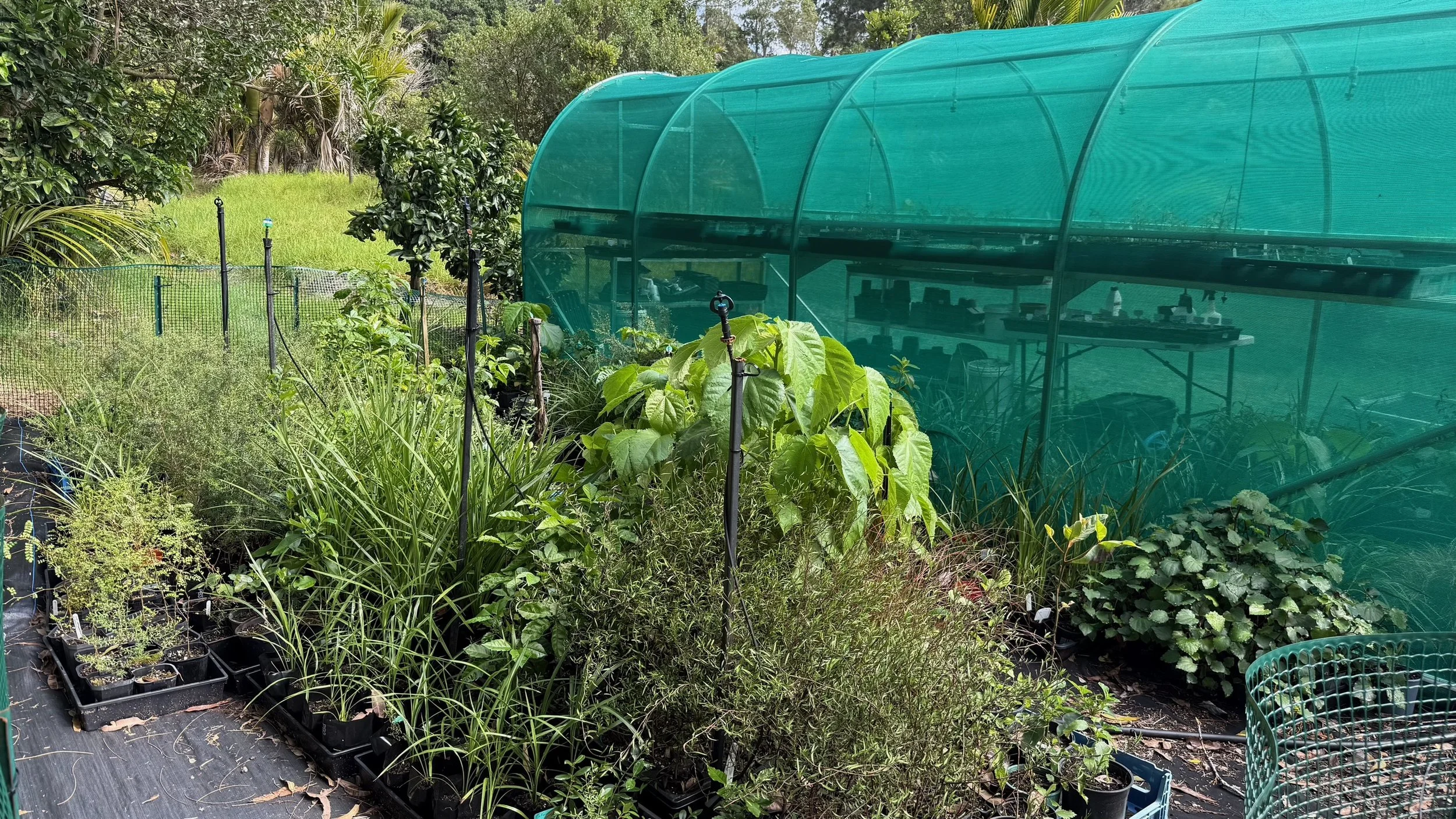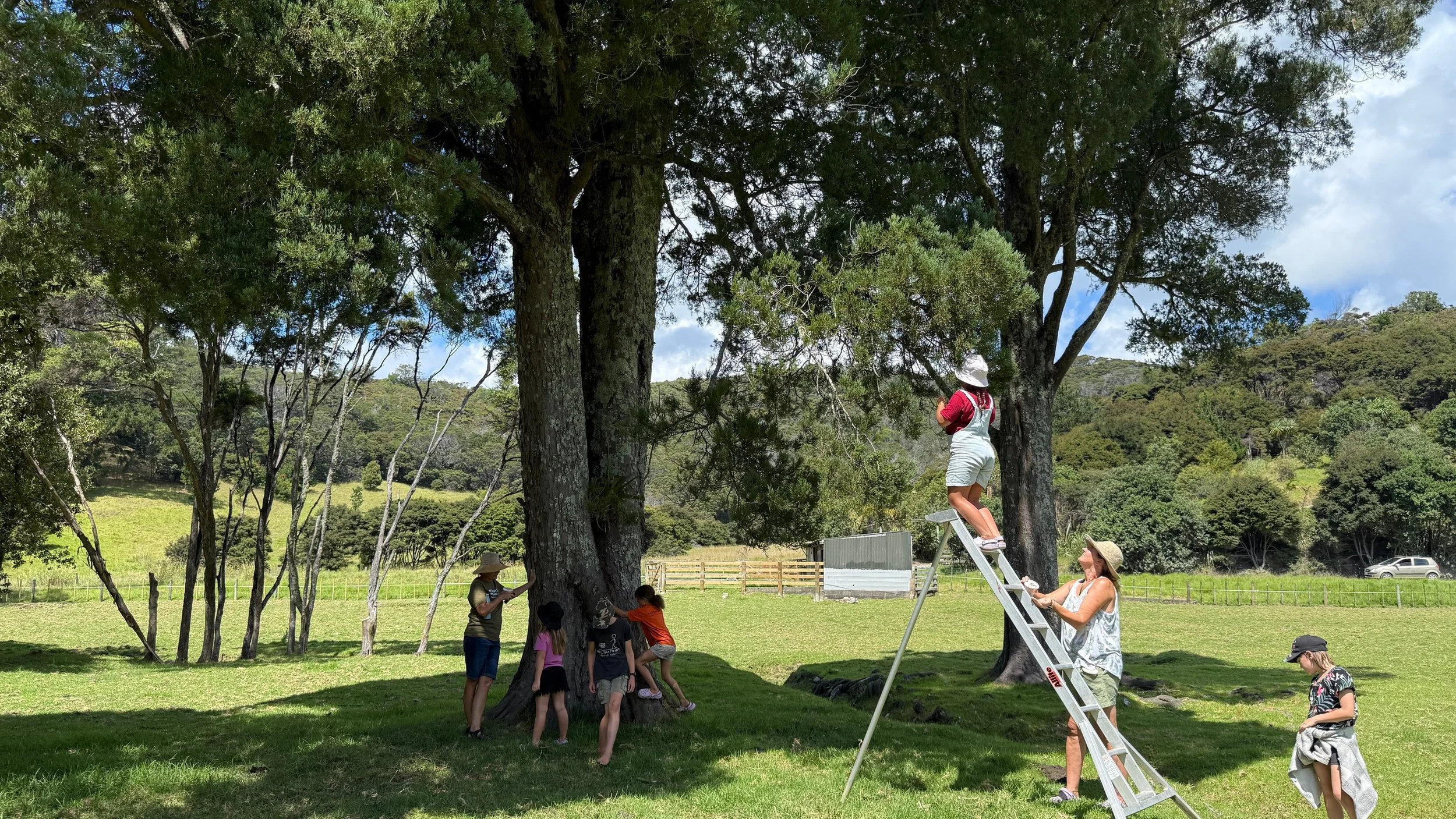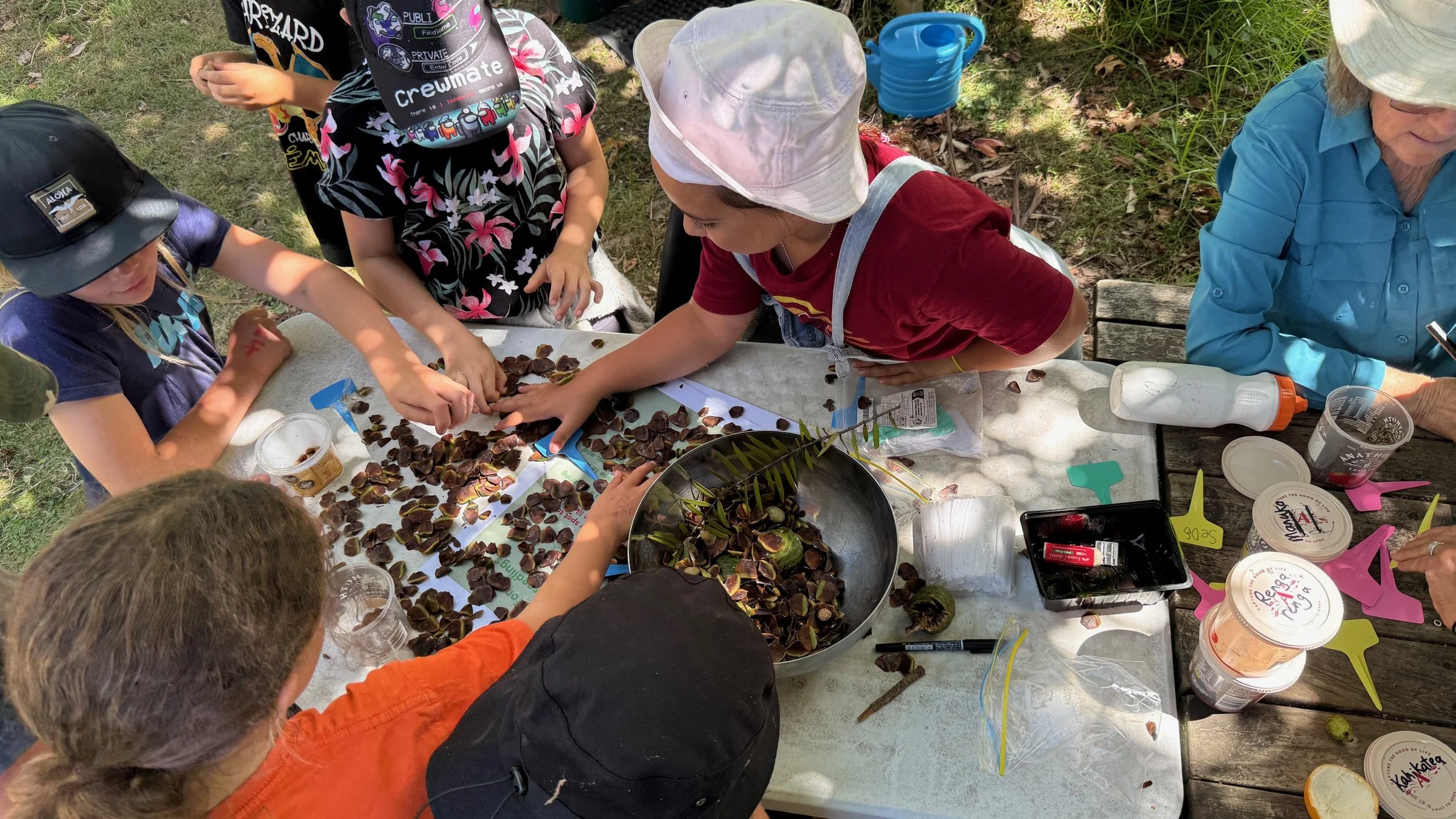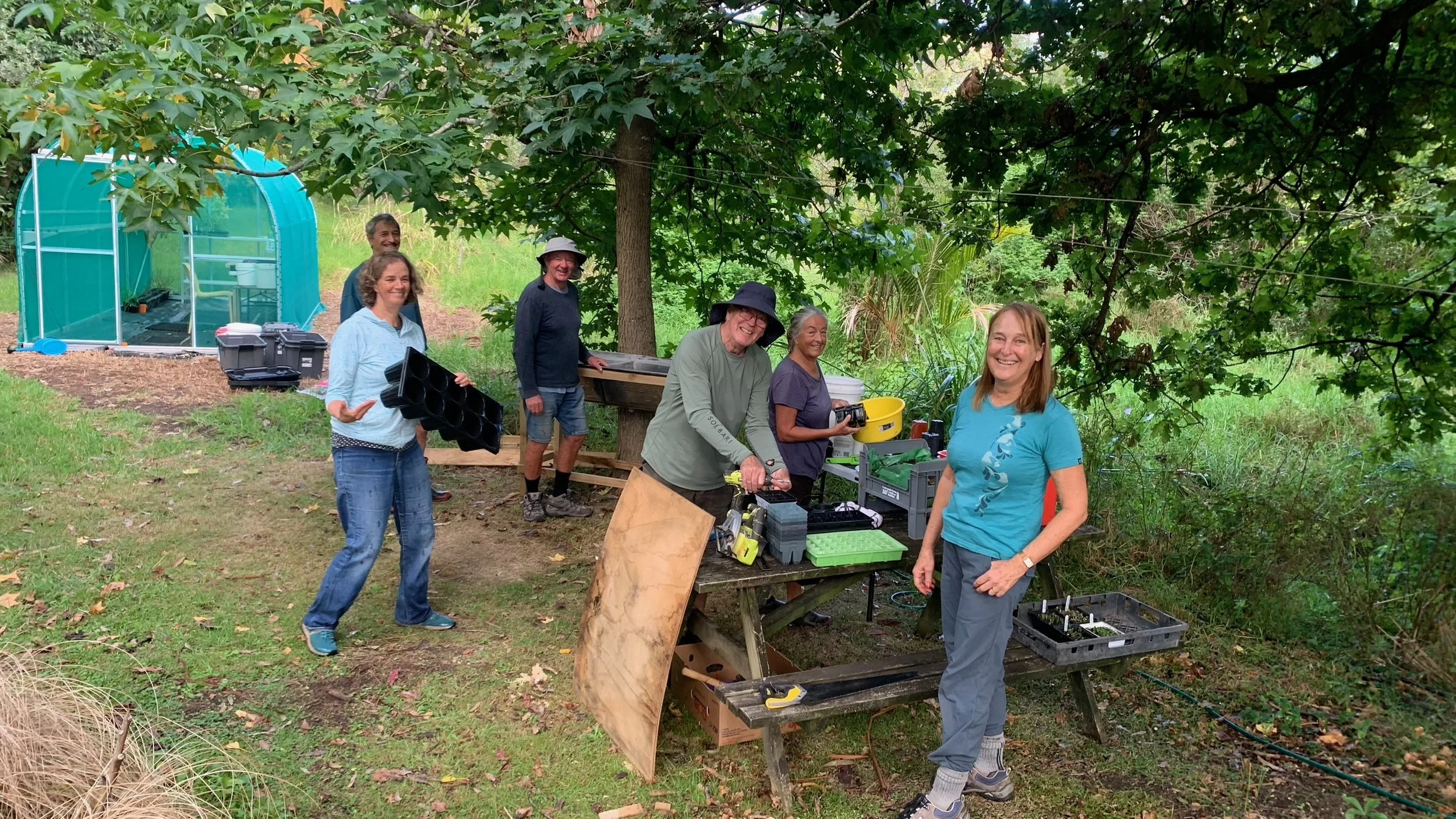Trial, error, and joy in a tunnel house
FRANCES McCLURE (Oruawharo Medlands Ecovision Volunteer)
The OME team at work – Raoul Stuart, Philippa Howcroft, Andy Thomson, Kim Bannister, Pru Smith and Jennifer Neads
In February 2024 volunteers from Oruawharo Medlands Ecovision built a tunnel house of shadecloth at our place. The cost of the kitset tunnel was funded by a Local Board grant, to help us grow the native plants we needed (but could not always find on island, or afford) to plant into the DOC Oruawharo wetland and surrounding area.
It was in a neglected and rarely visited corner of our block. Little did we suspect that it would become part of our daily commute - to visit, inspect, admire and puzzle over the contents. Building it was the first of a series of working bees from a small group of volunteers. Under the trees we’d all take part in the magic of propagating native plants - seed collecting, preparation and planting, thinning, pricking out, potting up, making cuttings and transplanting the bounty of small plants deposited at our place by our willing co-workers, the birds. This takes place along with delicious morning teas, swapping lively anecdotes, family stories and photos of local fauna, along with trying to sort the world’s problems.
None of us were native propagation experts so we learnt as we went along. I would sit and watch YouTube videos of Max Goodwin from Red Earth native plants(1), and pore over DOC advice about native plant propagation(2), and over the DOC calendar for seed collection(3).
We had some very basic infrastructure of concrete tubs, a hose, an old picnic table, plus Anamata’s finest second-hand plant pots and milk delivery trays. We were greatly encouraged by donations from locals of seeds and plants they’d been growing, as well as their expertise and advice.
After 70 years of wandering around enjoying native plants hugely, suddenly we started to notice those glossy black seed pods of flax, the shiny reds and purples of karo and pūriri, the golf balls of kohekohe, and the kauri cones casually discarded by kākā… and realise that therein lurked free trees. Now, walks in nature often include the harvesting of these wonderful resources. I did a couple of online courses (4)(5) for people starting native nurseries, but it was a bit demoralising to see the complex design layouts suggested. However, it did give birth to a small whiteboard of jobs for each working bee, to try and feel a bit professional and to focus on tasks needing doing.
We love our daily visits to check the ‘babies’, and enjoy the meditative sessions under the trees doing the repetitive but deeply satisfying jobs involved in transitioning the tiny plants to their final pots before we plant them. It still feels magical to see that exciting buckle in the soil followed by a green loop as a seed becomes a plant. It seems extraordinary that a dusting of mānuka seeds from a few capsules, or a tray sprinkled by the wind from pōhutukawa in the mast year last season, can create hundreds of plants. The kahikatea seeds with their jewel-like edible berries attached will slowly make their way to being 40 metres high, the tallest of Aotearoa’s trees, hopefully rising from the wetland area as when Ruawharo arrived at the bay 700 years ago.




None of this would be possible without the help and support of the volunteers who come so often to crack into a mountain of jobs, including the tedious washing of pots. When we’re away they take turns to come and check on the babies. My husband Kim manages to keep everything watered on a complex irrigation schedule, adjusting for summer droughts and storm drenchings.
Lurking in corners are trays disappointingly devoid of life – when DO you throw out a tray of seeds? I am told to “park my matai seeds under a hedge for 1-2 years”. There are seedlings which seem to succumb to some mysterious malaise or simply group hysteria. Jeremy Warden helped me to understand some of this as a physiological insult (sorry) or occasionally something infectious, though not measles - anthropomorphisms are a result of the number of retired doctors in the group! Had I thought about water heating in the black pipes over summer? Hmmm, no. When and how much should we fertilise them? When to pot into the final pots? Where next with mānuka seedlings, which hate root disturbance? Why are there parched plants next to ones knee deep in moss? So many questions - and so little help from Google.
Most rewarding activity: Having the Enviroschools kids from Kaitoke school wander round our block finding seeds, which they then prepped and planted. They took them back to school to care for (we’re keeping some spares), and hopefully the trees that grow will end up shading their playground and paddock.
Most expensive mistake: Offering to pay the grandchildren per kahikatea seed when we could only find 5… they found 80 and splurged at the Easter market.
Most challenging learning: Realising many plants have three names – Māori, Latin and English. THEN realising that many ‘proper’ names are changing: kāmahi, (or tawheo/tawhero/tawherowhero) is no longer Weinmannia racemosa but is now Pterophylla racemosa. It makes for a very full label!
Most uplifting moments: when locals or visitors donate towards our ongoing expenses like potting mix, fencing, and bridges just because they think what we’re doing is worthwhile.
Most helpful app: Aotearoa Species Identifier(6) (from a photo of a leaf we get full plant ID - we have grown 48 species so far).
Most disappointing intervention: I could not resist trying the seaweed spray which is like growth hormone in my vege patch… the pōhutukawa went sad and silvery despite their predilection for seashores; and a half teaspoon of fertiliser also demoralised the Aristotelia, Clematis, and Myrsine aquilonia.
Biggest surprise: how fast things grow! And how easy it has been to propagate some rare plants from seed. The hebe (now called Veronica) had 100% success rate from cuttings. The rengarenga seeds came up like a lush lawn and it seemed that within a month of potting up tī kōuka / NZ cabbage tree, their roots were on the move, glueing them to the ground. Native plants have a reputation for being a bit finicky to grow and rather slow. And indeed a few of ours have been, but most of them have burst forth with a minimum of fuss. Shelves and space in the tunnel house quickly filled up and the outside plant care space has been continually expanded.
Unexpected bonus: Working alongside volunteers who share our passion for plants and the desire to leave the valley a better place has resulted in some wonderful friendships and has been a great part of our lives here.
Frances tending to some kahikatea seeds
If he who plants a garden finds happiness, it seems to be true that for those of us who grow and plant native plants there is great satisfaction and delight. I reckon you should give it a go! We’ve learned heaps. We feel lucky to be part of OME and it feels good to be trying to make a difference to our motu and our world.
Frances McClure has lived on Aotea since 2021 but has owned a block of land here since 1981. After an early dalliance with growing stonefruit, the block has become a place to plant native and exotic trees as well as a slightly ridiculous range of edible plants - many of which have delighted (and been decimated by) local birds, and attracted the latest avian residents, kākāriki. She was a GP for 41 years before moving to Aotea. Along with partner Kim and eight grandchildren, she is now also trying to nurture hundreds of plants for the local wetland regeneration project at Medlands.
Acknowledgements
Huge thanks to the volunteers and Lotte, our incredibly able and helpful coordinator, as well as all those who brought the tunnel house, plants, seeds, potting mix, and expertise to us. Local businesses like Island Aviation, Sealink, GB Cartage, Aotea Gas and Garden, and local arborists have all helped with free or discounted products and services.
References
Red earth native plants. https://www.youtube.com/@redearthnativeplants165
DOC. Seed collection and propagation guide for native trees and shrubs
DOC. Calendar for seed collectiong – trees. https://www.doc.govt.nz/get-involved/run-a-project/restoration-advice/native-plant-restoration/ecosource-seeds/collection-and-propagation-guide-trees/calendar-for-seed-collecting/
Native Plant Nursery Guide. https://www.tiakitamakimakaurau.nz/media/ku4l0yb1/native-plant-nursery-guide-2024.pdf
New Zealand Plant Conservation Network. Module 3: Plant nursery management and propagation. https://www.nzpcn.org.nz/conservation/training/module-3-propagation/
He Aha Te Momo? What is this? He kōmaka momo mō Aotearoa / A species classifier for Aotearoa. https://what-is-this.cms.waikato.ac.nz


